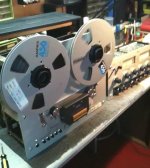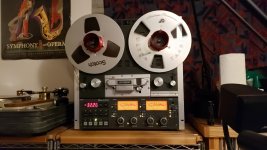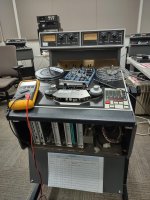Thanks Kevin, that is good news. Tape has a very unique sonic texture especially when levels are pushed.
I feel like I'm living my audio life backwards, first Salas makes vinyl irresistible and now you've made tape a intriguing temptation! I have a few friends who would enjoy doing direct to tape recording just for fun. I might need to get serious about some mics.
What do you think is a fair price for a working but not serviced/improved 2 channel MX5050 is?
I feel like I'm living my audio life backwards, first Salas makes vinyl irresistible and now you've made tape a intriguing temptation! I have a few friends who would enjoy doing direct to tape recording just for fun. I might need to get serious about some mics.
What do you think is a fair price for a working but not serviced/improved 2 channel MX5050 is?
Last edited:
Thanks Kevin, that is good news. Tape has a very unique sonic texture especially when levels are pushed.
I feel like I'm living my audio life backwards, first Salas makes vinyl irresistible and now you've made tape a intriguing temptation! I have a few friends who would enjoy doing direct to tape recording just for fun. I might need to get serious about some mics.
What do you think is a fair price for a working but not serviced/improved 2 channel MX5050 is?
My neighbor picked up TWO MX5050's for around 700 each.
I overhauled/calibrated one.... another's sitting on the waiting list.
I got my MX-5050s free a couple of years ago, the MX-50 were not free, but because they were both dead I got them for $400 each. Both are now running well. I had JRF relap and align the heads on the later MX-50N II because when I attempted to calibrate the record path I could not do it because the playback head and erase head had been tweaked by someone in the past.
The older MX-5050 seem to be full of Nichicon electrolytics that soldier on indefinitely without replacement, despite that I recommend replacing them. The MX-50/55 are a bit later and are full of electrolytics that fail. Both of mine needed electrolytics in the audio path and logic debounce circuits replaced before they would even run. I replaced every single electrolytic which was a laborious undertaking, but they've been reliable since.
I would recommend an MX-50N or NII as well as the MX-55N over the MX-5050, but those decks are comparatively rare and the MX-5050 particularly BII-2 isn't, and there are lots of parts available for the MX-5050 on eBay and elsewhere.
If you shop around you may find a good running MX-5050BII-2 or BIII-2 for as little as a few hundred dollars at places like hamfests and electronic flea markets. As wiseoldtech advises a very good deck should be attainable for no more than $700 if you shop around.
Please do not pay the prices asked for an MX-5050 on eBay if it is above what he suggested, these decks are grossly overpriced and you have no idea what you are getting. The MKIV and BIII tend to go for more money and basically offer the ability to set supply and take up reel torque independently. Shipping is anxiety provoking. I've been lucky.. I picked up the MKIII in Lebanon NH on the way home from Montreal in March of 2019, the BII-2 was dropped off here by the friend who gave it to me.
The older MX-5050 seem to be full of Nichicon electrolytics that soldier on indefinitely without replacement, despite that I recommend replacing them. The MX-50/55 are a bit later and are full of electrolytics that fail. Both of mine needed electrolytics in the audio path and logic debounce circuits replaced before they would even run. I replaced every single electrolytic which was a laborious undertaking, but they've been reliable since.
I would recommend an MX-50N or NII as well as the MX-55N over the MX-5050, but those decks are comparatively rare and the MX-5050 particularly BII-2 isn't, and there are lots of parts available for the MX-5050 on eBay and elsewhere.
If you shop around you may find a good running MX-5050BII-2 or BIII-2 for as little as a few hundred dollars at places like hamfests and electronic flea markets. As wiseoldtech advises a very good deck should be attainable for no more than $700 if you shop around.
Please do not pay the prices asked for an MX-5050 on eBay if it is above what he suggested, these decks are grossly overpriced and you have no idea what you are getting. The MKIV and BIII tend to go for more money and basically offer the ability to set supply and take up reel torque independently. Shipping is anxiety provoking. I've been lucky.. I picked up the MKIII in Lebanon NH on the way home from Montreal in March of 2019, the BII-2 was dropped off here by the friend who gave it to me.
I am attacking the dreaded "head bump" on my Otari MX-5050 MKIII-8. Its low-end malady is similar to many other tape machines out there (not all, esp. Studer) in that it has a rather large wiggle in the frequency response below 200 Hz---about +/-2 db, whilst the remainder of the audible range is very flat once the machine is properly calibrated. I have designed a two-opamp circuit on a ~1.5"x1" PCB that will fit onto my Otari audio board (just barely). It reduces the 4 db swing to about 1.3 db---on paper anyway. Off to have the PCB made and see if I can duplicate the paper circuit for real. I'll have to hand-select the 1% resistors and 2% capacitors that are available.
Good luck with the latest improvement, sounds like a worthwhile improvement to me, the bass bump is pretty audible in the MX-5050 and MX-50 2 track machines.
I've been working on slightly improved LF compensation for my tape pre-amplifier designs which I am using on a slightly modified MX-50..
In other news I have moved on to a new world, the Otari is a nice entry level deck, but not a stellar performer. I came to this conclusion after purchasing a number of commercial releases on 15ips tape and being very disappointed in their sound quality which did not match the glowing reviews nor what I had heard in two other instances.
Yup, I bought a recently overhauled and fully serviced Studer A810. And yes the differences in performance between an A810 and an MX-50 are not small. The price differential in the day wasn't small either. The Otari was expensive, the Studer insanely expensive. (The version of the A810 I have retailed for about 7X what the MX-50 did in the mid/late 1980s.) Today the delta is if anything in practical terms even larger. Otaris are cheap comparatively despite the asking prices on eBay and the Studer isn't.
I've been working on slightly improved LF compensation for my tape pre-amplifier designs which I am using on a slightly modified MX-50..
In other news I have moved on to a new world, the Otari is a nice entry level deck, but not a stellar performer. I came to this conclusion after purchasing a number of commercial releases on 15ips tape and being very disappointed in their sound quality which did not match the glowing reviews nor what I had heard in two other instances.
Yup, I bought a recently overhauled and fully serviced Studer A810. And yes the differences in performance between an A810 and an MX-50 are not small. The price differential in the day wasn't small either. The Otari was expensive, the Studer insanely expensive. (The version of the A810 I have retailed for about 7X what the MX-50 did in the mid/late 1980s.) Today the delta is if anything in practical terms even larger. Otaris are cheap comparatively despite the asking prices on eBay and the Studer isn't.
Attachments
<snip> Off to have the PCB made and see if I can duplicate the paper circuit for real. I'll have to hand-select the 1% resistors and 2% capacitors that are available.
If you use Panasonic 1206 0.1% thin film resistors you will not have to select them. 😀 The capacitors are another matter particularly if you want good ps foil types rather than Vishay or Wima commodity caps that you can get in 1% tolerance.
Kevin: I'm kinda impressed you bought something that didn't need total restoration! But do you now have more R2R decks than tapes...
It appears that those are only available in SMD, and quite expensive as well. In my retired bliss, I have more time than money, so I'll just get the 1%ers and sort.😱If you use Panasonic 1206 0.1% thin film resistors you will not have to select them. 😀 The capacitors are another matter particularly if you want good ps foil types rather than Vishay or Wima commodity caps that you can get in 1% tolerance.
Congrats on your new Studer A810! They are FINE machines! I have one as well, and it's superb!! I believe they were about $10,000 when new, so I'll guess you probably had to pay 4 or 5 grand for one---eh?
Kevin: I'm kinda impressed you bought something that didn't need total restoration! But do you now have more R2R decks than tapes...
Actually I have a significant number of very, very expensive transfers which is why I purchased the A810. I plan to add more in the coming years. (No more than a couple of year unless I hit the motherlode.. LOL)
It appears that those are only available in SMD, and quite expensive as well. In my retired bliss, I have more time than money, so I'll just get the 1%ers and sort.😱
Congrats on your new Studer A810! They are FINE machines! I have one as well, and it's superb!! I believe they were about $10,000 when new, so I'll guess you probably had to pay 4 or 5 grand for one---eh?
Yes, they are SMD, but pretty easy to work with using a reasonable set of SMD tweezers and solder iron. I guess I never thought of $0.66 resistors as being expensive compared to typical audiophile fare.. LOL Discount is substantial at 10 pieces, I use them almost everywhere. (including my tube designs)
Add 40% to 150% to your estimate of what a new A810 cost in the mid 1980s, apparently by the end of the run in the early 1990s the dollar had strengthened considerably against the Swiss franc and demand was dropping which drove it down. (Best numbers I have got so far.) There were a lot of options. Mine is a standard A810 2/2 VU HS which would have been nearer the top of the price range than the bottom. I have the transformer coupled output cards rather than the direct drive - the direct drive output cards are considered a bit more transparent, but are rare and expensive. The console versions were the most expensive variants, but happy to have a chassis model because they take up a lot less space. Great if you like lifting 70lb tape machines.
I do plan on the wood sides and handles off of eBay at some point to make it easier to move around when I need to work on it. (Not an immediate concern admittedly)
Any plans to mod the Studer A810? As you probably know, Fencer over at tapeheads thinks their playback amplifiers are abominable; he HUGELY prefers fire bottles to opamps for tape playback. However, I don't agree with him that all opamps are terrible.
Last edited:
In trying to insert a AntiHeadBump equalizer circuit in my Otari MX-5050 MKIII-8 tape recorder, I have come to a difficulty in the schematic. I believe there is a mistake, as I cannot get the circuit to work properly in LT Spice XVII. I have attached a screenshot of the circuit from my service manual. The input to the circuit is via R106 on the left side; the output is through R133 on the right. The Hi Speed/Lo Speed selection is done via the FETs, with Q107 turning on whilst at 15 ips, enabling the HF EQ adjustment VR102. Can anyone spot the error? Kevin?
Attachments
Last edited:
What voltages are you applying to the gates of the JFETs?
I would remove the jfets in the LTspice model to check the EQ coefficients. The circuit definitely works, there are a lot of them in Otari decks.
I would remove the jfets in the LTspice model to check the EQ coefficients. The circuit definitely works, there are a lot of them in Otari decks.
Actually, I did just that---I just put in the path for 15 ips EQ--- VR102, etc., and left the FETs out (I must assume they work as they should). R131's value isn't specified on the schematic, so I put in 4.3K (found on another very similar Otari schematic). But it doesn't matter anyway---the circuit comes nowhere close to operating properly regardless of that value. It just seems that the values or wiring has to be different to actually work.
Last edited:
Best bet is eBay, that is where I got all of my spare Otari parts. I no longer have parts for MX-5050s since I no longer own any. I own two MX-50 and a Studer A810 these days. I still get parts for these machines on eBay. Interestingly parts for the MX-50 are harder to find than Studer parts or MX-5050 parts.
The ATR 102 is an excellent machine and in another league altogether from the MX-5050. The Otaris are OK the ATR102 and A810 are great. The A810 cost about 5 - 6x what an MX-5050 did in the day so that's not really surprising.
The ATR 102 is an excellent machine and in another league altogether from the MX-5050. The Otaris are OK the ATR102 and A810 are great. The A810 cost about 5 - 6x what an MX-5050 did in the day so that's not really surprising.
The MX-5050 that's been sitting on my basement shop is finally gone, thank god.
My neighbor finally came and got it.
I told him to use it for a "parts" machine" for the other MX-5050 that I restored for him two years back.
Plus, he's also got the Technics RS1500 that I did for him last year.
In my opinion a better machine.
The machine was loaded with issues..
Capstan motor seized, needing a $300+S/H rebuild at Athan in Cali.
Servo board was sloppily inserted, hanging down.... lord knows the condition.
Heads needing realignment due to some DIY joker poking a screwdriver around.
Dented bottom cover due to dropping it.
Etc etc.
I won't waste my time on such things..... I draw the line.
My neighbor finally came and got it.
I told him to use it for a "parts" machine" for the other MX-5050 that I restored for him two years back.
Plus, he's also got the Technics RS1500 that I did for him last year.
In my opinion a better machine.
The machine was loaded with issues..
Capstan motor seized, needing a $300+S/H rebuild at Athan in Cali.
Servo board was sloppily inserted, hanging down.... lord knows the condition.
Heads needing realignment due to some DIY joker poking a screwdriver around.
Dented bottom cover due to dropping it.
Etc etc.
I won't waste my time on such things..... I draw the line.
I enjoyed the challenge of fixing a couple of basket cases (the two MX-50s, and the MKIII) but I was not on the clock, and the repairs on the face of it were not that economic. Had they not come to me it is likely at least a couple of those machines would have ended up as parts for other machines. I did not recoup my investment in time or money on either of the MX-5050s but at least they have gone on to people who are enjoying and don't have the resources for a better machine. And I had fun.<snip>
The machine was loaded with issues..
Capstan motor seized, needing a $300+S/H rebuild at Athan in Cali.
Servo board was sloppily inserted, hanging down.... lord knows the condition.
Heads needing realignment due to some DIY joker poking a screwdriver around.
Dented bottom cover due to dropping it.
Etc etc.
I won't waste my time on such things..... I draw the line.
What you say makes sense. In general I have come to the conclusion that the best MX series decks for home recording and playback at 7.5/15ips 2 track are the MX-50 and the MX-55.. The MTR machines are worthwhile but too bulky for many home listening rooms.
I run/own a small Facebook group for Otari enthusiasts which continues to grow steadily, there is certainly a following for these machines.
I've also had a pretty questionable dabble with 3 head dual capstan cassette decks.. It does surprise me just how good some of the last gasp machines of the early 2000s actually are.
All for fun!
Last edited:
- Home
- Source & Line
- Analogue Source
- So you think you want to play with tape: An Otari Story


